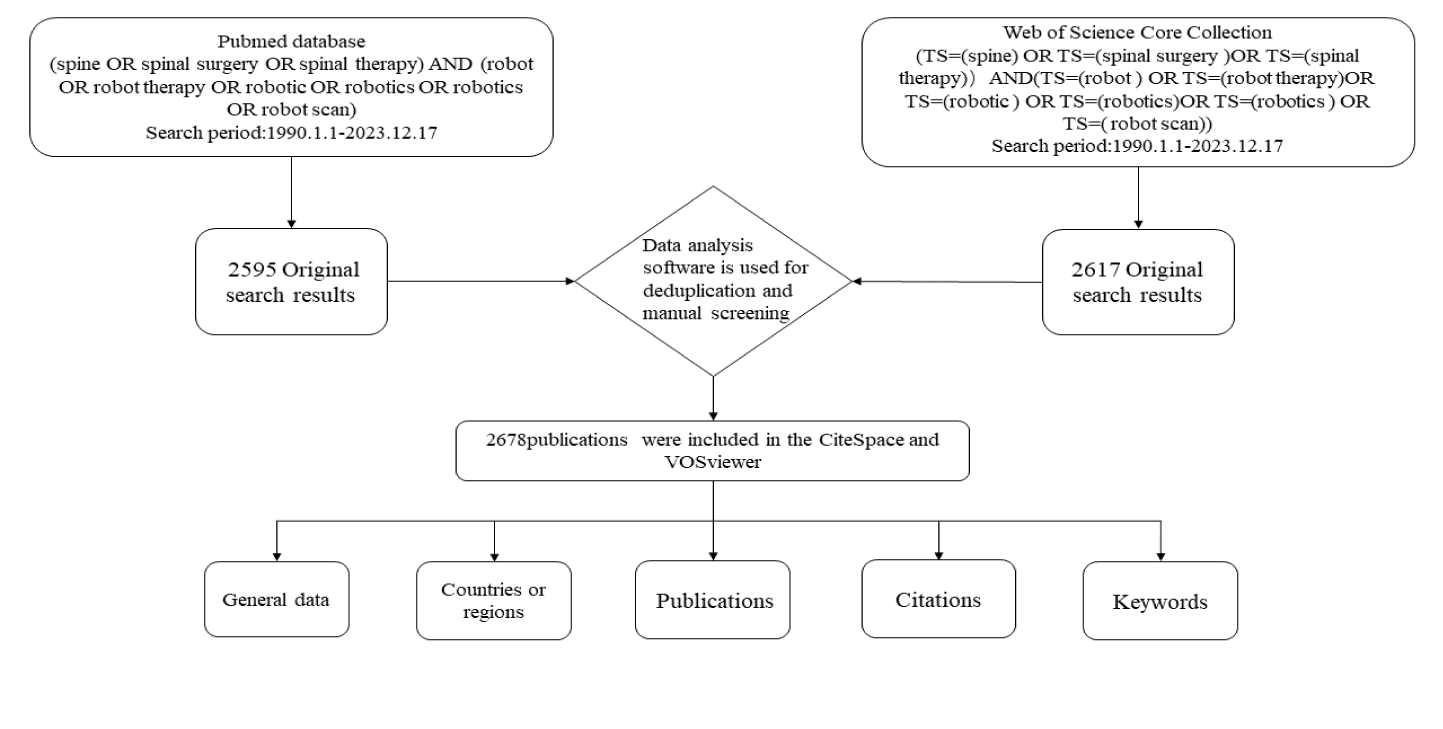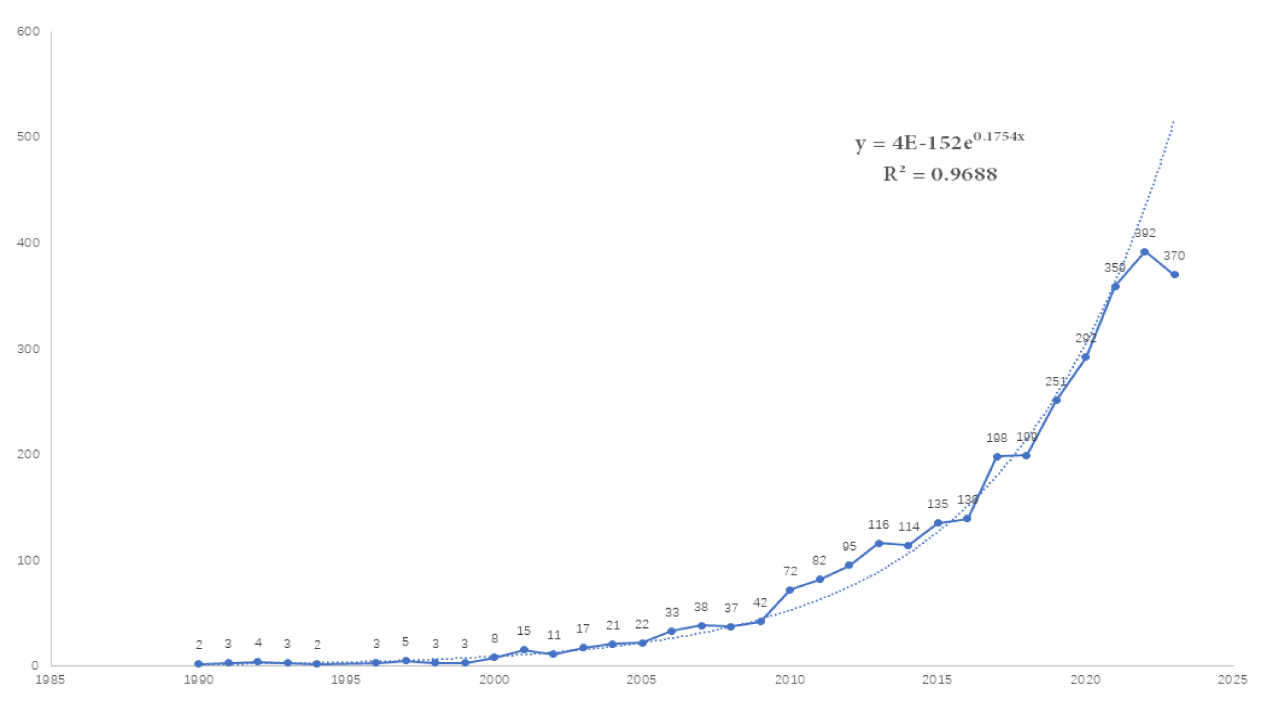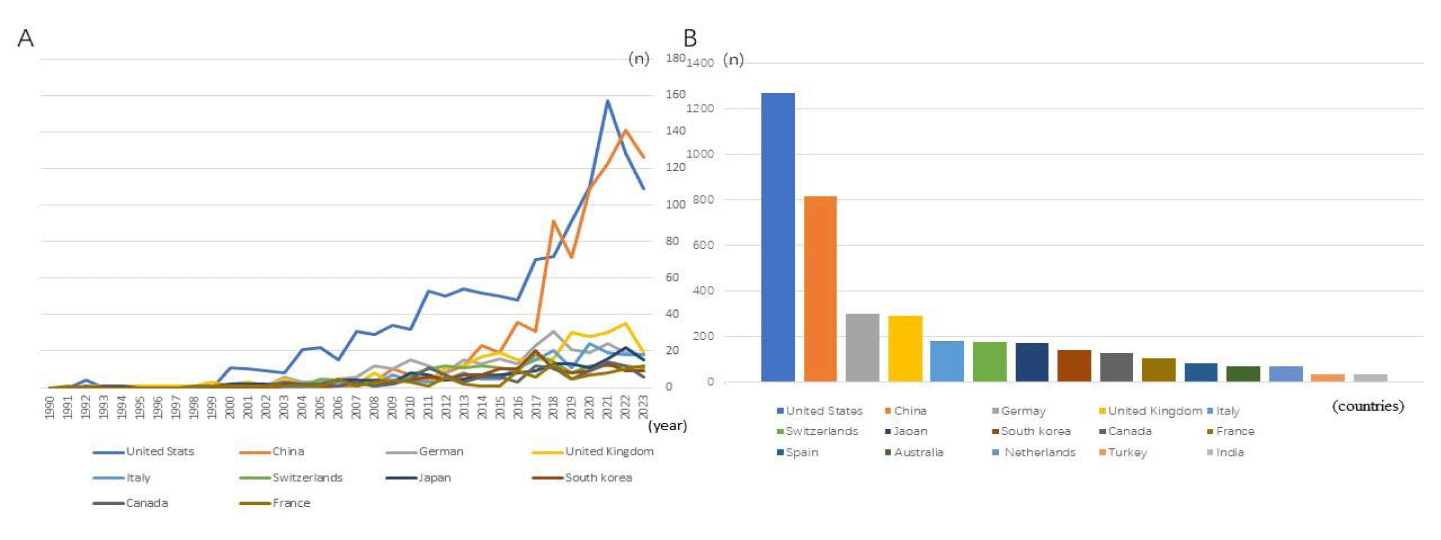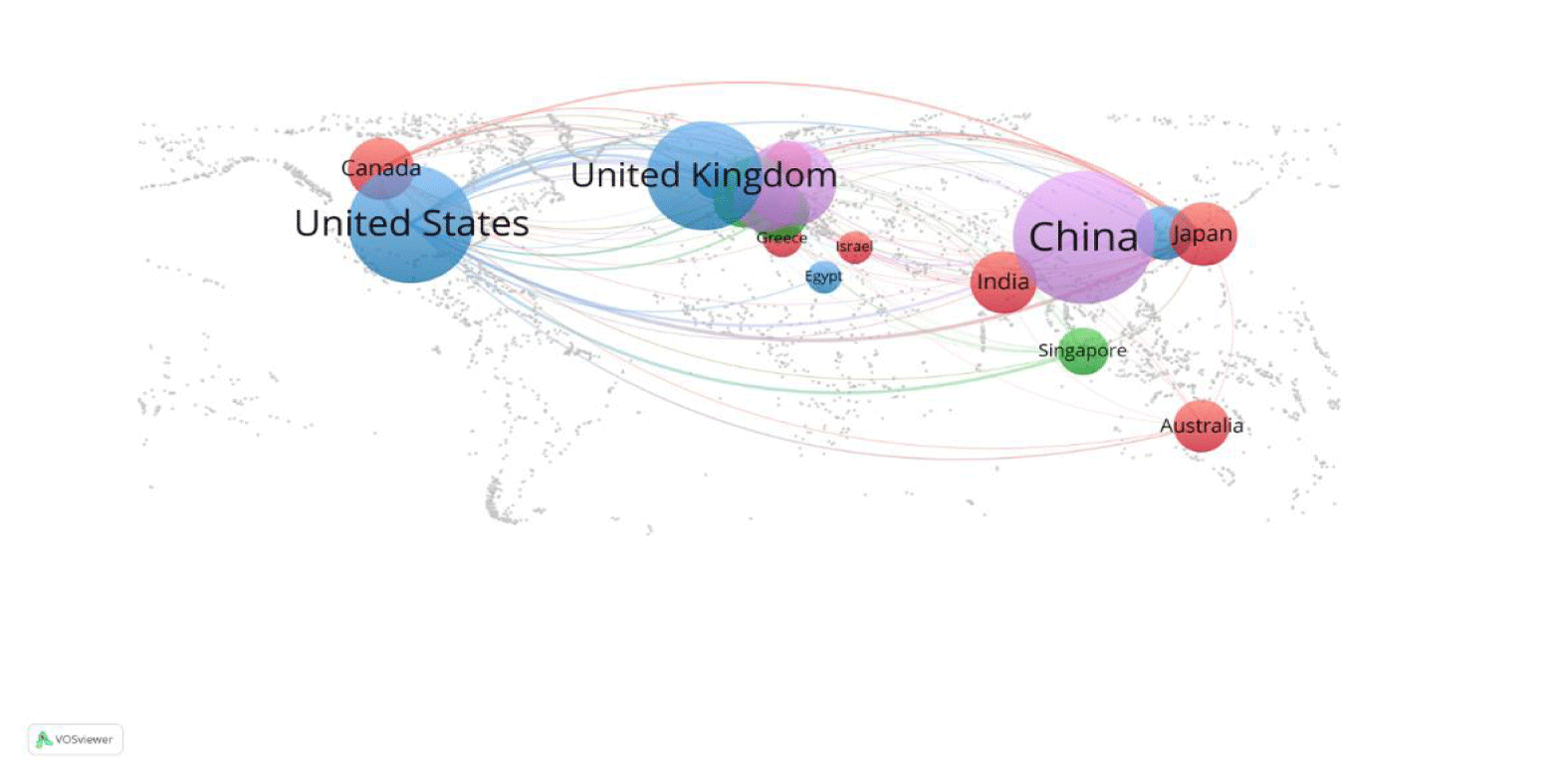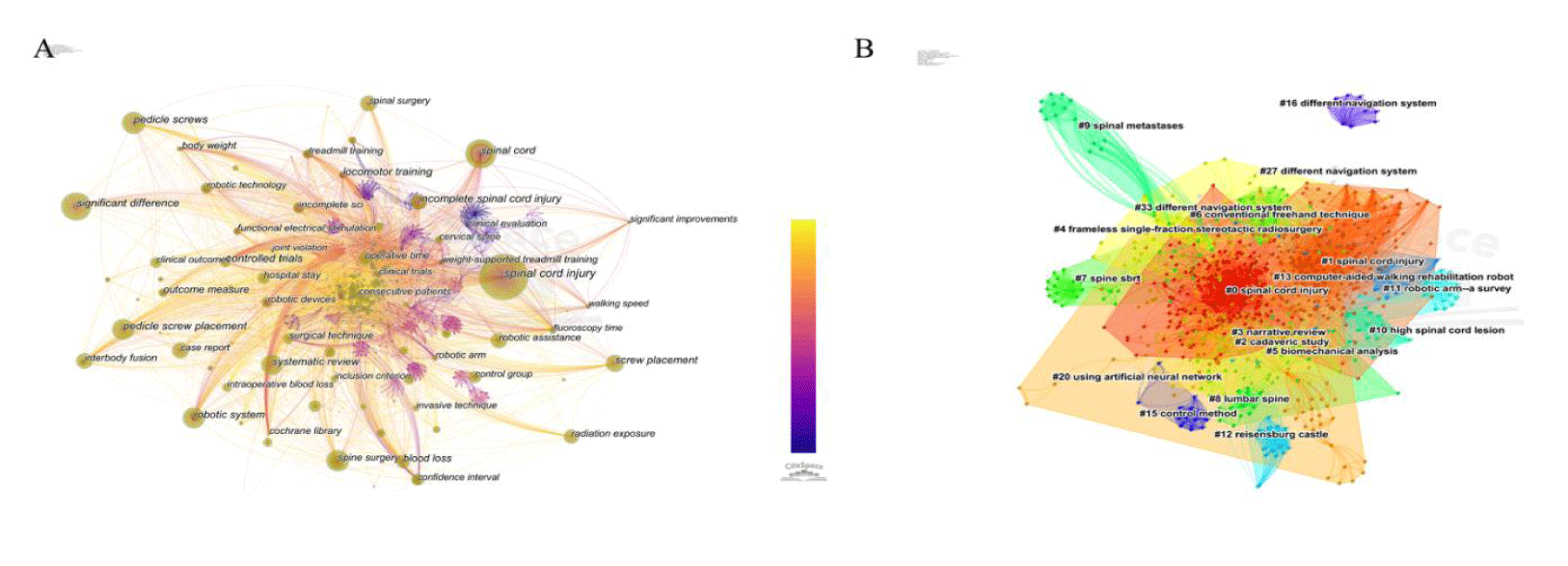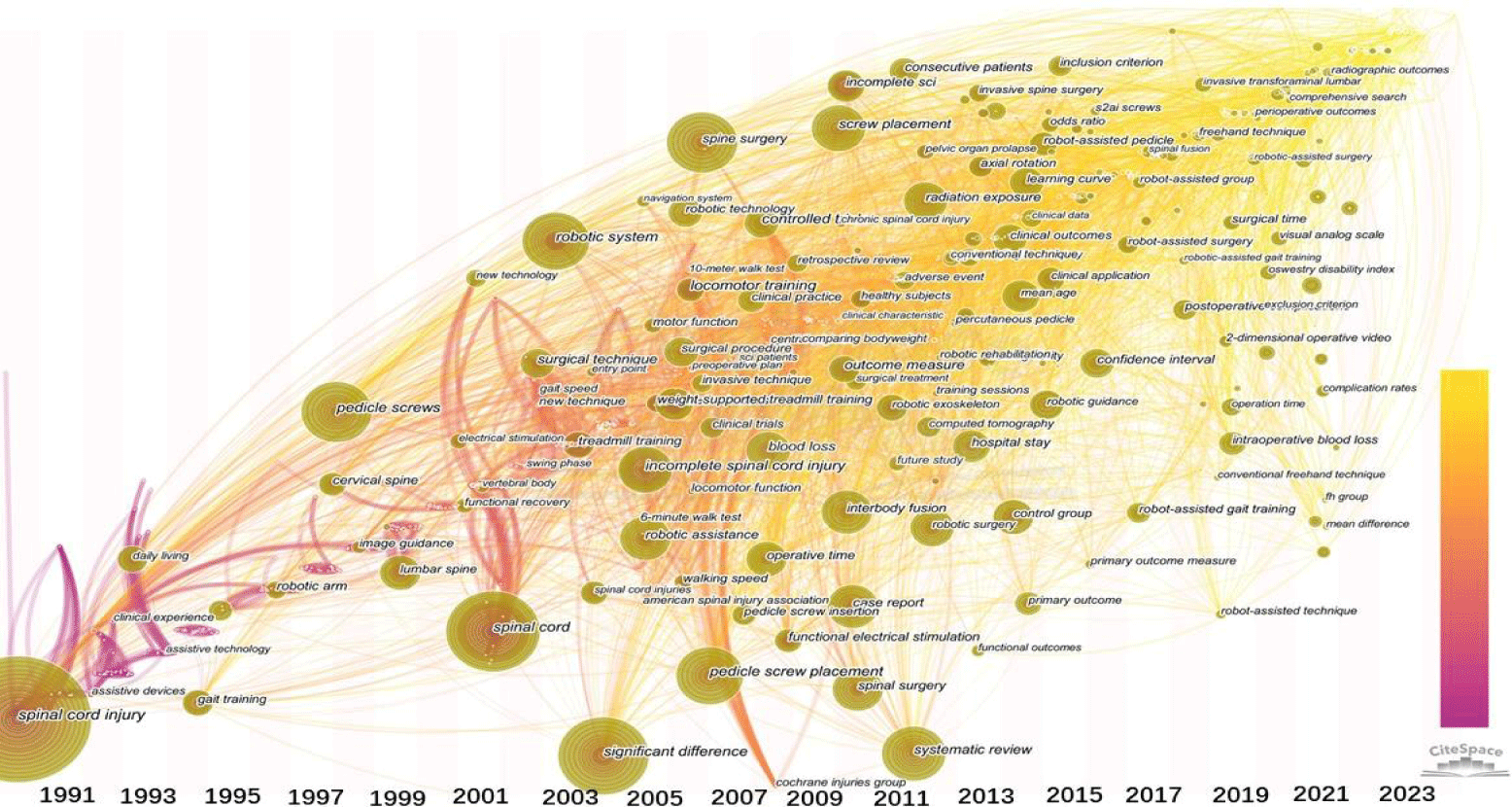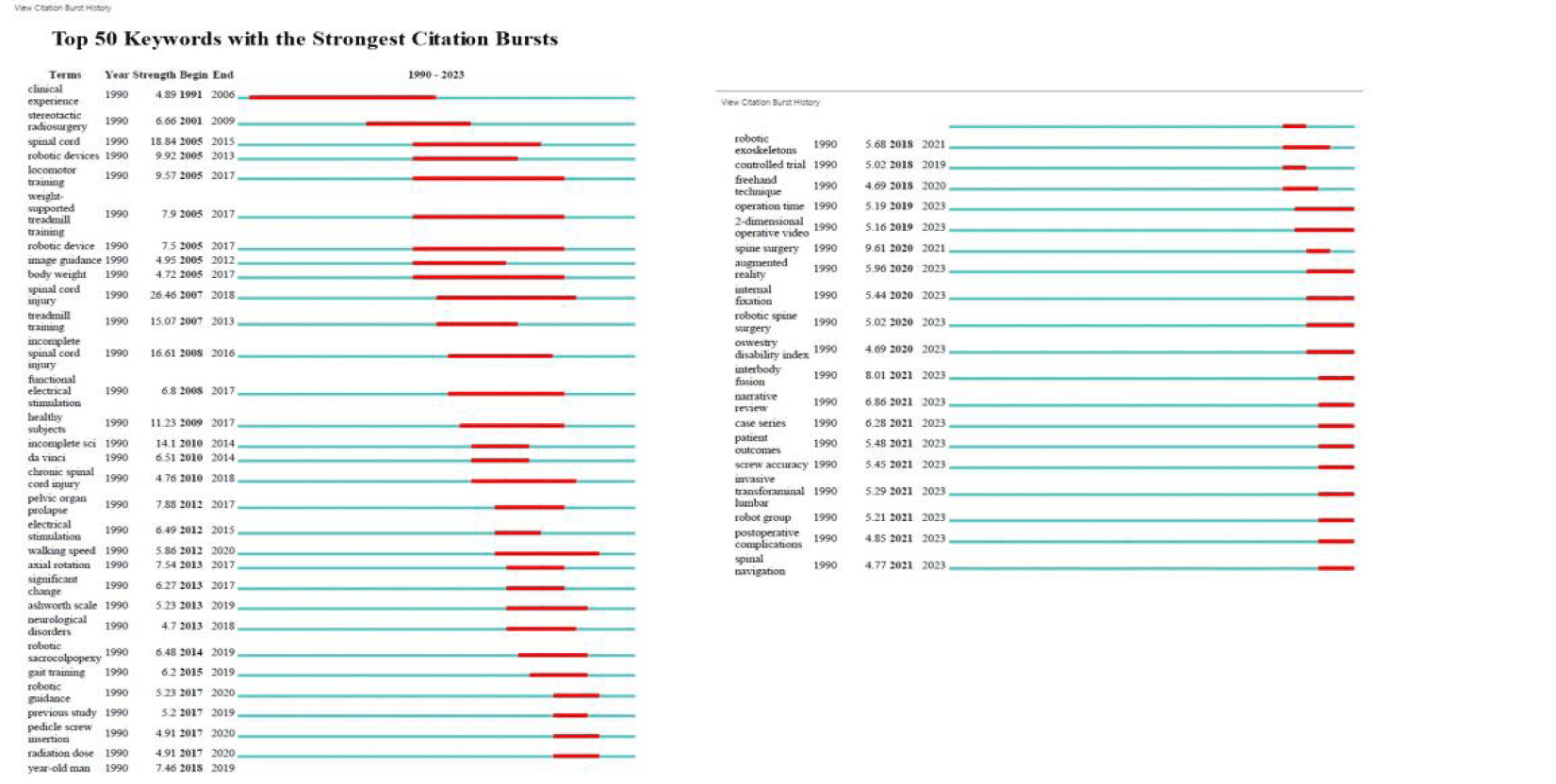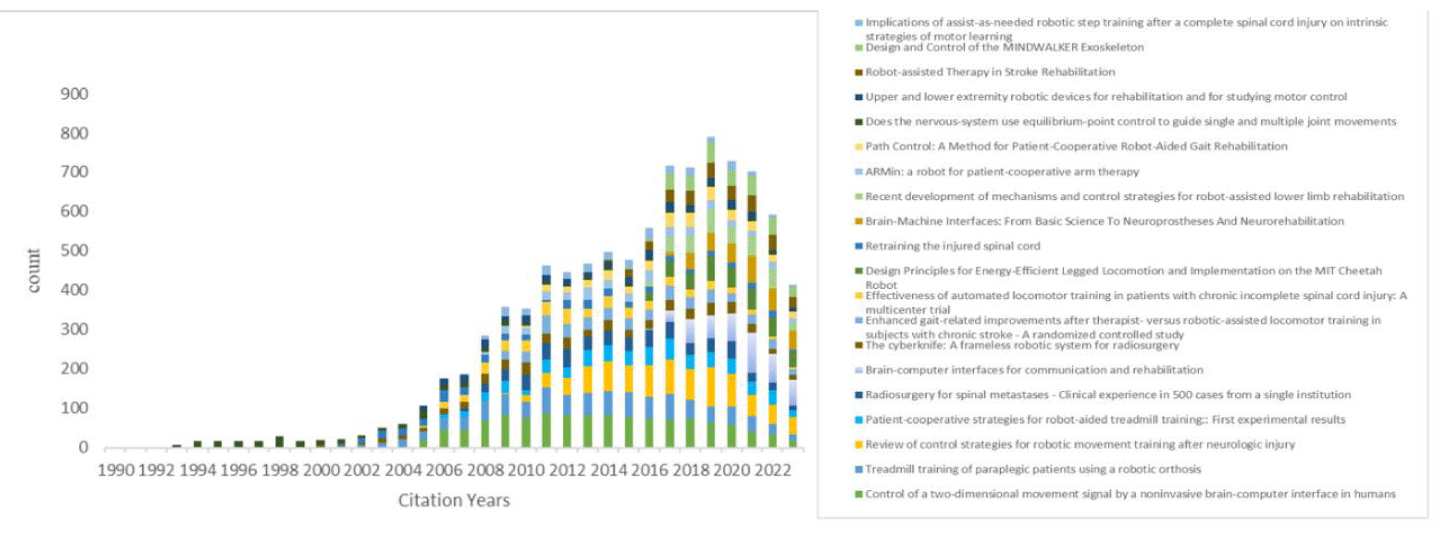Medicine Group. 2024 January 26;5(1):064-082. doi: 10.37871/jbres1873.
A Bibliometric Analysis: The Application of Robotic Technology in Spine Surgery in the Past 30 Years
Yuan Zhou, Chongwen Ma, Ziyan Wei and Xuewen Kang*
- Bibliometrics
- Spine surgery
- Robotic technology
- Application
- CiteSpace
- VOS viewer
Abstract
Purpose: The aim of this study is to comprehensively analyze the application of robotic technology in spine surgery and display the current research status in this field.
Methods: To investigate the distribution and characteristics of robotics in spinal surgery, the publications in PubMed and web of science was examined and analyzed. We utilized CiteSpace and VOSviewer to review and visualize academic literature from the previous 30 years on the use of robotic technology in spine surgery.
Results: According to the findings of the research, it indicates that robotics is becoming more widespread in spine surgery, with robotics playing an important role in pedicle screw placement, intraoperative navigation, imaging guidance, and minimizing radiation exposure for surgeons and surgical teams. how to establish a set of standards, how to reduce personnel radiation exposure in the operating room, postoperative follow-up between traditional and robotic surgery, and the prognosis and incidence of complications such as spondylosis, and so on are all topics that will be discussed.
Conclusion: The study looked into the recovery time following robotic surgery, the expense of hospitalization, the robotic technology in terms of time during surgical procedures, blood loss, and implant placement accuracy, which are all topics that will be investigated more in the future. While there are some discrepancies in government, physician, and patient views, expectations, and clinical data for robotic surgery, robots will increasingly be used in areas that demand great precision. The application of robotic technology in spine surgery will be extensive.
Introduction
Orthopedic treatment is primarily surgical, and it involves people of all ages, from children to the elderly, and portions of the body ranging from the trunk to the limbs, as well as organs from the spine, spinal cord, peripheral nerves, joints, and the hands and feet. Congenital diseases, inflammations, deformities, metabolic bone disorders, bone and soft-tissue cancers, degeneration, fractures, and dislocations are all examples of orthopedic diseases [1]. The surgical approach entails a full-examination procedure followed by minimally invasive therapy, with the incision size steadily reduced without impacting the operative field. With the advent of technology and medical technology, spine surgery has seen several technical developments, including advancements in surgical procedures, implants and biologics, and gadgets like computer-assisted navigation and surgical robots. Because of its precision, low trauma, speedy recovery, and excellent short-term therapeutic impact, surgical robotic technology is becoming more widely used in surgery [2].
Robot-assisted brain biopsies were the first known use of robots in neurosurgery, which occurred in 1988 [3]. Robots for pedicle screw placement, intraoperative navigation, and imaging guidance were not introduced into spinal surgery until around 2000 [4]. The da Vinci Surgical System's commercial success is attributed to three main features: the use of a stereoscopic endoscope to restore lost depth perception, an immersive environment in which the surgeon can gaze at his hand during surgery, and sufficient degrees of freedom combined with wrist movement [4,5].
In order to explore research hotspots and frontiers in particular subjects, bibliometric analysis has been widely used to calculate the research direction and the frequency of usage of keywords and terms by countries, institutions, and authors. Bibliometric analysis has been verified in surgical domains [6], and it has also been published in orthopedic related literature, from the first da Vinci robotic surgery in China in 2007 to the current robotic surgery technology in municipal hospitals. Despite the fact that spine surgery has been a hot topic in orthopedic research for decades, no bibliometric studies on the use of robotics in spine surgery have been reported [7-9]. As a response, we gathered research literature on the use of robotic technology in spine surgery in the last 30 years and utilized Cite Space and VOSviewer to analyze and visualize the data, providing researchers with potential research directions in robotic spine surgery.
Methods and Materials
Search strategy and data collection
To investigate the distribution and characteristics of robotics in spinal surgery, the core literature in PubMed and Web of science was examined and analyzed. The PubMed database was searched on December 17, 2023, using the search words (spine OR spinal surgery OR spinal therapy) AND (robot OR robot therapy OR robotic OR robotics OR robotics OR robot scan), with the search year being 1990 to 2023. The web of science database was searched by using the search words(TS=(spine) OR TS=(spinal surgery )OR TS=(spinal therapy) AND (TS=(robot ) OR TS=(robot therapy)OR TS=(robotic ) OR TS=(robotics)OR TS=(robotics ) OR TS=( robot scan)). A total of 2595 articles were screened out from the PubMed database and 2617 articles from the WOS database, and a total of 2678 articles were screened after deduplication and manual screening using data analysis software.
Data analysis
Import data into Cite Space and VOS viewer software for analysis to explore circulation, distribution countries, key articles, and keywords analysis (Figure 1).
The corresponding bibliometric parameters were exported to Microsoft Excel 2021 to identify the publication trend, the distribution of document types, and the largest contributors, including prolific authors, institutions, countries or regions, and journals. CiteSpace and VOSviewer were used to illustrate the map and depict the strength of the collaborations between authors, institutions, countries, and journals to demonstrate their scientific influence in this field. Lastly, the co-occurrence of countries/origens in VOSviewer, keywords with the strongest citation bursts, and co-cited references in CiteSpace were utilized to visualize the knowledge evolution, hot topics, and potential research frontiers in this field. In the CiteSpace-generated network visualization maps, the node's color denotes clustering, its size indicates the quantity of publications or the frequency of a keyword, the link between the nodes indicates a cooperative or co-occurrence relationship, the link's thickness suggests strength, and there are two lines: a red line representing the burst period and a blue line representing the period. In the VOSviewer-generated overlay visualization map, the node's color denotes clustering, its size indicates the quantity of publications or the frequency of a keyword, the link between the nodes denotes a cooperative or co-occurrence relationship, and the link's thickness indicates the strength of the relationship.
Results
Number of articles published
We initially retrieved a total of 2678 publications from the Web of Science Core Collection (WoSCC) database and PubMed database, including Article, Review Article, Case Report, Abstract, Clinical Trial and so on, meanwhile we use a scatterplot to display the number of articles published each year to see whether there are any trends in the use of robotic technology in spine surgery. Each year between 1990 and 2000, fewer than ten papers were published. The number of papers on spinal robotics research has steadily increased since 2009. The number of papers published in 2013 surpassed 100. Since then, the number of papers published has risen steadily, and in 2021, the total number of papers published will exceed 300, reaching 359. The peak year was 2022. A total of 392 articles were published in the previous five years, which accounted for approximately 14.63% of the included publications (Figure 2). The overall number of citations was 66940, with an average of 19.02 citations per paper.
Active countries and regions
In the last 30 years, 756 countries and regions have published 2,678 related articles, with the United States ranking first with 1270 articles; China second with 817 articles; Germany 299 articles; United Kingdom 294 articles; Italy 181 articles; Switzerland 178 articles; Japan 174; South Korea 139;Canada 128; France 105; Spain 85;Australia 71. From a chronological standpoint, the quantity of papers published in each country has risen year after year (Figures 3A,B). In the United States, for example, only 4 articles were published in the two years between 1990 and 1991, compared to nearly 500 pieces in the 4 years between 2020 and 2023. At the same time, China's 10-year growth rate from 2012 to 2022 is impressive, and these two countries are important research partners (Figure 4). Cooperation is extremely important to the United States, and it has tight relations with China, Japan, Germany, the United Kingdom, France, Australia, and Italy, as well as other countries and regions.
Active authors
Author co-occurrence maps can provide information on influential research groups and potential collaborators. It can help researchers find potential collaborators [10]. In the 30 years from 1990 to 2023. There were 2678 publications published throughout the 30 years between 1990 and 2023 about the use of robotic technology in spinal surgery. The phrases were transmitted all over the world, and the number of publications and articles produced steadily increased year after year. (Figure 5A,B) Wei Tian, Yajun Liu, Robert Riener, Ray De Leon,V Edgerton, David Reinkensmeyer, Mehdi Mirba-gheri, Jason Liounakos, Martin Pham, and others are well-known in this discipline; their teams have contributed significantly to the advancement of spine surgery and surgical robots. Professor Tian Wei's group [11], for example, has spent a long time researching and applying precise, minimally invasive, and intelligent orthopedic diagnosis and treatment. He discovered the pathophysiology of dysphagia following cervical spine surgery for the first time and revolutionized the surgical concept; he proposed a new theory of paravertebral ossification and shifted the design direction of artificial intervertebral discs for the first time [11,12]. The research of the Robert Riener [13] team focuses on the investigation of human-machine sensorimotor interactions. This includes the creation of user-collaborative robotic devices and neurorehabilitation virtual reality technology.
Active institution and journals
There are 656 first author units among the 2678 articles. The Department of Neurosurgery collaborates with almost all research institutes across the world, and thus plays an essential role in advancing scientific research globalization. In addition, the Uuited State has a close relationship with these institutions, and in the following studies, U.S. authors and institutions remain the top one in this field (Figure 6) .These journals are the ones with the largest number of publications in the field, including Spine (n = 72), World Neurosurgery (n = 69), Journal Of Neuroengineering And Rehabilitation (n = 61), International Journal Of Radiation Oncology Biology Physics (n = 53), International Journal of Medical Robotics And Computer Assisted Surgery (n = 52) nd so on.
The results of keywords analysis
The results of keywords analysis are mainly the extraction of noun terms in the literature, mostly from the titles, abstracts, keywords, and index word positions of the literature. The graph above depicts the number of keywords found in the literature, whereas the graph below depicts the frequency with which terms appear in the literature. The more yellow the figure's color, the more closely linked terms are shown figure 7. The spinal cord injury is at the heart of everything, and it's linked to things like surgical techniques, robotic systems, spinal cord, interbody fusion, and incomplete spinal cord injury, pedicle screw placement, robotic system, and robotic aid, surgical approach frequently and regularly. This figure illustrates that there are a total of 12 clusters within this field, with spinal cord injury, cadaveric study, narrative review, frameless single-fraction stereotactic being the predominant factor. In table 1, the Latent Semantic Indexing (LSI) is a straightforward and practical topic modeling technique that leverages the Singular Value Decomposition (SVD) method to extract the subject headings from textual data. Furthermore, matrix factorization can be effectively employed in collaborative filtering recommendation algorithms. The algorithm can analyze the correlation between label (keywords) and cluster so as to analyze different research directions (Figures 7A,B, table 1).
| Table 1: Keyword clustering information table. | |||||||||||
| Cluster ID | Cluster | Size | Silhouette | Mean (Year) | Label (LSI) | ClusterI ID | Cluster | Size | Silhouette | Mean (Year) | Label (LSI) |
| 0 | Spinal cord injury | 247 | 0.737 | 2011 | Spinal cor injury; locomotor training; walking; stance; lumbosacral spinal cord adapts; animal models; using innovative technologies; cardiovascular changes; spinal excitability changes; automated locomotor training incomplete spinal cord injury; people; lokomat; joint position sense; limb; reliability; validity; impact; daily living; machine learning | 6 | Conventional freehand technique | 45 | 0.895 | 2011 | Cervical spine; influence; sagittal plane centers; range; motion; segment mechanics; motion; rotation; navigation; trends; usage | lumbar spine; discectomy; wide posterior releases; inferior facetectony; thoracolumbar; sagittal plane centers; myelopathy patients; simulation; biomechanical study; usage |
| 1 | Spinal cord injury | 246 | 0.6 | 2017 | Accuracy; safety; pedicle screw placement; robot; airo; first experiences; acetabular surgery-an analysis; invasive techniques; unstable sacral fractures; invasive triangular fixation | placement; comparison; thoracolumbar fractures; fluoroscopy-assisted percutaneous pedicle; prospective comparative study; osteoporosis; mis refresh; effect; lumbar pedicle; adjacent segment disease | 7 | Spine sbrt | 33 | 0.979 | 2009 | Systematic review; meta-analysis; conventional freehand technique; arm-based navigation; insertion; pedicle; accuracy; individuals; tampa scale; comparing robot-assisted technology | spinal cord injury; walking; locomotor training; conventional freehand technique; accuracy; arm-based navigation; individuals; tampa scale; comparing robot-assisted technology; incomplete spinal cord |
| 2 | Cadaveric study | 71 | 0.737 | 2015 | Systematic review; utility; learning algorithms; lumbar spine disease; machine; history; spinal robotics; pediatric spinal deformity; anterior humbar total disc replacement surgery; robotics | spine surgery; machine learning applications; pediatric spine deformity; real registration technology; kyphosis disease; image-guided spinal surgery; alar-iliac fixation; surgeon; accuracy; developing peri-operative rehabilitation | 8 | Lumbar spine | 32 | 0.96 | 2003 | Spinal implants; accuracy assessment; clinical acceptance; spineassist; surgical robot; retrospective study; treating multiple vertebrae; tomography image guidance; precision; clinical practice | tomography image guidance; setup accuracy; using cone beam; patients; spine radiosurgery; treating multiple vertebrae; precision; clinical practice; pointer device system; using stereotactic body frames |
| 3 | Narrative review | 70 | 0.999 | 1989 | Clinical evaluation; worktable system; cord-injured persons; robot; rehabilitation robotics; clinical experience; robotic assistant; desktop | rehabilitation robotics; clinical experience; robot; robotic assistant; desktop; worktable system; cord injured persons; clinical evaluation | 9 | Spinal metastases | 30 | 0.992 | 1992 | Individuals; development; assistive computer interface; semg; assistive devices; wearable robot; robotic rehabilitation exoskeleton; quadriplegia; invasive electrocorticography upper-limb motor imagery; assistive technology | people; occupational therapists’ views; robotic aids; disabilities; assistive devices; wearable robot; robotic rehabilitation exoskeleton; quadriplegia; invasive electrocorticography upper-limb motor imagery; assistive technology |
| 4 | Frameless single-fraction stereotactic | 62 | 0.917 | 2007 | Placement; spine surgery; robotic-assisted pedicle; learning curve; interbody fusion; robot-assisted anterior lumbar; using retroperitoneal approach; orthopaedics; joints; fiducial-free real-time image-guided robotic radiosurgery | accuracy; cadaveric study; pedicle screw placement; robotic guidance system; spinal navigation; intra-operative fixation; spine frame; orthopaedics; joints; fiducial-free real-time image-guided robotic radiosurgery | 10 | High spinal lesion | 24 | 0.916 | 2013 | Pelvic organ prolapse; robot-assisted sacrocolpopexy, review; current status; case; robotrelated complications; patients; multicenter assessment; robot-assisted lumbar arthrodesis; year reoperations | spinal metastases; stereotactic body radiotherapy; vertebral compression fracture; multi-institutional study; osteolytic renal cell carcinoma; risk; robot-related complications; reirradiation; praspinal lesions; spina bifida; |
| 5 | Biomechanical analysis | 55 | 0.893 | 2005 | cyberknife; frameless single-fraction stereotactic radiosurgery; spine; benign tumors; clinical outcomes; technology; image-guided hypo-fractionated stereotactic radiosurgery; accuracy; evaluation; spinal radiosurgery | spinal lesions; frameless real-time image-guided stereotactic radiosurgery, evaluation; radiosurgery—present status; anthropomorphic phantom study; future prospect; accuracy; robot-assisted laparoscopic sacral colpopexy; initial experience; high –valume laparoscopic reference center | 11 | Robitic arm –a survey | 22 | 0.985 | 2005 | ; humber spine; kinetics; hip abduction; role; active back-support exoskeleton; assistive strategies; simulation; different navigation systems; surgeon degenerative diseases | lumbar; upright position; initial assessment; cone-beam computed tomography system; imaging; evaluating human cadaveric specimens; prototype; active back-support exoskeleton; assistive strategies; simulation |
Keyword time zone map analysis
In the 30-year time map of 1990 and 2023, it can be seen that spinal cord injury has always been a hot spot (Figure 8) and the topics surrounding spinal cord injury are also hot spots. Interbody fusion, spine surgery, robotics and pedicle screw placement have all been linked since 2013 and are getting closer. Due to the complexity of spinal surgery, the difficulty of operation, and the depth of surgery, the early robotic technology could not meet the clinical needs, and it increased year by year in 2012 [1,5]. From 2019 to 2023, although affected by the epidemic, the three years of spinal surgery and robotic technology the related hot period. The number of articles in this area will continue to increase in the next few years, which is related to today's high-intensity work, unscientific life-style, resulting in spinal diseases, as well as the booming development of robotics, accurate surgery and fast recovery. After 2015, terms such as freehand technique, robot-assisted group, odds ratio, intraoperative blood loss, radiation dose, pedicle screw accuracy, inclusion criterion, and navigation system began to appear, and Beijing Jishuitan Hospital played an important role in this field [14].
Research frontiers and hotspots
A burst keyword refers to the sudden emergence of a word or an article over a period of time, and is an important indicator of the research frontier in the field of inferred features research. Identify and analyze terms using highlighters to explore the frontiers of research. A total of 50 keywords with the highest citation bursts were extracted in this study. The duration of the keyword's appearance is indicated by a red bar. The burst words after 2023 were spinal navigation, postoperative complications, robot group, transforaminal lumbar screw accuracy and so on.
The relevant frontier development and hotspots of robotic technology in spine surgery are extracted based on the aforementioned research findings. We used retrieval, qualitative, and categorical methodologies to review existing literature on the use of robotics in spine surgery. The number of articles published has typically increased, and the number of publications in the last five years is significantly larger than before. The major content of the literature can be reflected in subject terms/keywords, and their combination can show hotspots and trends in the research topic [15] (Figure 9).
Cited publications and references
Table 2 lists the top 20 cited publications; Wolpaw, JR; McFarland, DJ, et al. [18] published a research article in ‘’Proceedings of The National Academy of Sciences of The United States’’ in 2004, which had the highest number of citations (n = 1163). There is a clinical experience article entitled “Radiosurgery for spinal metastases - Clinical experience in 500 cases from a single institution’’, and although it was published in 2007, it ranked 4th in terms of citations. Furthermore, 5 of the top 20 cited articles were authored by Chaudhary, Ujwal entitled” Brain-computer interfaces for communication and rehabilitation [16]’’ in 2016. At the same time, it can be seen that” Lateral flexion of a compliant spine improves motor performance in a bioinspired mouse robot [17]”ranks first among highly cited articles in 2023 (Table 3, figure 10).
| Table 2: Top 20 most cited papers on the application of robotic technology in spine surgery in the past 30 years. | |||||||
| Rank | Title | Authors | Article source | Publication Year | DOI | Total Citations | Average per Year |
| 1 | Control of a two-dimensional movement signal by a noninvasive brain-computer interface in humans [18] | Wolpaw, JR; McFarland, DJ | Proceedings Of The National Academy Of Sciences Of The United States Of America | 2004 | 10.1073/pnas.0403504101 | 1163 | 58.15 |
| 2 | Review of control strategies for robotic movement training after neurologic injury [19] | Marchal-Crespo, Laura; Reinkensmeyer, David J. | Journal Of Neuroengineering And Rehabilitation | 2009 | 10.1186/1743-0003-6-20 | 892 | 59.47 |
| 3 | Patient-cooperative strategies for robot-aided treadmill training:: First experimental results [20] | Riener, R; Lünenburger, L; Jezernik, S; Anderschitz, M; Colombo, G; | Ieee Transactions On Neural Systems And Rehabilitation Engineering | 2005 | 10.1109/TNSRE.2005.848628 | 574 | 30.21 |
| 4 | Radiosurgery for spinal metastases - Clinical experience in 500 cases from a single institution [21] | Gerszten, Peter C.; Burton, Steven A.; Ozhasoglu, Cihat; Welch, | Spine | 2007 | 10.1097/01.brs.0000251863.76595.a2 | 537 | 31.59 |
| 5 | Brain-computer interfaces for communication and rehabilitation [22] | Chaudhary, Ujwal; Birbaumer, Niels; Ramos-Murguialday, Ander | Nature Reviews Neurology | 2016 | 10.1038/nrneurol.2016.113 | 466 | 58.25 |
| 6 | The cyberknife: A frameless robotic system for radiosurgery [23] | Adler, JR; Chang, SD; Murphy, MJ; Doty, J; Geis, P; Hancock, SL | Stereotactic And Functional Neurosurgery | 1997 | 10.1159/000099863 | 465 | 17.22 |
| 7 | Enhanced gait-related improvements after therapist- versus robotic-assisted locomotor training in subjects with chronic stroke - A randomized controlled study [24] | Hornby, T. George; Campbell, Donielle D.; Kahn, Jennifer H.; Demott, Tobey; | Stroke | 2008 | 10.1161/STROKEAHA.107.504779 | 432 | 27 |
| 8 | Effectiveness of automated locomotor training in patients with chronic incomplete spinal cord injury: A multicenter trial [25] | Wirz, M; Zemon, DH; Rupp, R; Scheel, A; Colombo, G; Dietz, V; Hornby, TG | Archives Of Physical Medicine And Rehabilitation | 2005 | 10.1016/j.apmr.2004.08.004 | 395 | 20.79 |
| 9 | Design Principles for Energy-Efficient Legged Locomotion and Implementation on the MIT Cheetah Robot [26] | Seok, Sangok; Wang, Albert; (Michael) Chuah, Meng Yee; Hyun, Dong Jin; Lee, | Ieee-Asme Transactions On Mechatronics | 2015 | 10.1109/TMECH.2014.2339013 | 362 | 40.22 |
| 10 | Retraining the injured spinal cord [27] | Edgerton, VR; de Leon, RD; Harkema, SJ; Hodgson, JA; London, N; Reinkensmeyer, DJ; | Journal Of Physiology-London | 2001 | 10.1111/j.1469-7793.2001.0015b.x | 348 | 15.13 |
| 11 | Brain-Machine Interfaces: From Basic Science To Neuroprostheses And Neurorehabilitation [22] | Lebedev, Mikhail A.; Nicolelis, Miguel A. L. | Physiological Reviews | 2017 | 10.1152/physrev.00027.2016 | 322 | 46 |
| 12 | Recent development of mechanisms and control strategies for robot-assisted lower limb rehabilitation [28] | Meng, Wei; Liu, Quan; Zhou, Zude; Ai, Qingsong; Sheng, Bo; Xie, Shengquan (Shane) | Mechatronics | 2015 | 10.1016/j.mechatronics.2015.04.005 | 317 | 35.22 |
| 13 | ARMin: a robot for patient-cooperative arm therapy [21] | Nef, Tobias; Mihelj, Matjaz; Riener, Robert | Medical & Biological Engineering & Computing | 2007 | 10.1007/s11517-007-0226-6 | 317 | 18.65 |
| 14 | Path Control: A Method for Patient-Cooperative Robot-Aided Gait Rehabilitation [29] | Duschau-Wicke, Alexander; von Zitzewitz, Joachim; Caprez, Andrea; Luenenburger, Lars; | Ieee Transactions On Neural Systems And Rehabilitation Engineering | 2010 | 10.1109/TNSRE.2009.2033061 | 314 | 22.43 |
| 15 | Does The Nervous-System Use Equilibrium-Point Control To Guide Single And Multiple Joint Movements [30] | BIZZI, E; HOGAN, N; MUSSAIVALDI, FA; GISZTER, S | Behavioral And Brain Sciences | 1992 | 10.1017/S0140525X00072538 | 314 | 9.81 |
| 16 | Upper and lower extremity robotic devices for rehabilitation and for studying motor control [31] | Hesse, S; Schmidt, H; Werner, C; Bardeleben, A | Current Opinion In Neurology | 2003 | 10.1097/00019052-200312000-00010 | 300 | 14.29 |
| 17 | Robot-assisted Therapy in Stroke Rehabilitation [32] |
Chang, Won Hyuk; Kim, Yun-Hee | Journal Of Stroke | 2013 | 10.5853/jos.2013.15.3.174 | 299 | 27.18 |
| 18 | Design and Control of the MINDWALKER Exoskeleton [33] | Wang, Shiqian; Wang, Letian; Meijneke, Cory; Thomas; | Ieee Transactions On Neural Systems And Rehabilitation Engineering | 2015 | 10.1109/TNSRE.2014.2365697 | 298 | 33.11 |
| 19 | Implications of assist-as-needed robotic step training after a complete spinal cord injury on intrinsic strategies of motor learning [34] | Cai, Lance L.; Fong, Andy J.; Otoshi, Chad K.; Liang, Yongqiang; Burdick, Joel W.; Roy, | Journal Of Neuroscience | 2006 | 10.1523/JNEUROSCI.2266-06.2006 | 295 | 16.39 |
| 20 | Restoring sensorimotor function through intracortical interfaces: progress and looming challenges [35] | Bensmaia, Sliman J.; Miller, Lee E. | Nature Reviews Neuroscience | 2014 | 10.1038/nrn3724 | 290 | 29 |
| Table 3: Top 15 most cited papers in this field in2023. | |||||
| Rank | Title | Authors | Article source | Publication Year | DOI |
| 1 | Lateral flexion of a compliant spine improves motor performance in a bioinspired mouse robot [17] | Bing, Zhenshan; Rohregger, Alex; Walter, Florian; Huang, Yuhong; | Science Robotics | 2023 | 10.1126/scirobotics.adg7165 |
| 2 | Lightweight and Powerful Vacuum-Driven Gripper With Bioinspired Elastic Spine [36] | Long, Yongzhou; Zhang, Zhuang; Xu, Zhuowei; Gu, Enlin; Lu, Qiujie; | Ieee Robotics And Automation Letters | 2023 | 10.1109/LRA.2023.3325714 |
| 3 | Robot-assisted versus fluoroscopy-guided pedicle screw fixation of thoracolumbar compression fractures [37] | Li, Yongjun; Wei, Xing; Liang, Yonghui; Song, Guangze | Medicine | 2023 | 10.1097/MD.0000000000036430 |
| 4 | Acetabular cup positioning in primary routine total hip arthroplasty-a review of current concepts and technologies [38] | Sathikumar, Aravind Sai; Jacob, George; Thomas, Appu Benny; | Arthroplasty | 2023 | 10.1186/s42836-023-00213-3 |
| 5 | The role of robotic surgery in neurological cases: A systematic review on brain and spine applications [39] | Lin, Tong; Xie, Qinghai; Peng, Tao; Zhao, Xianxiao; Chen, Dongliang | Heliyon | 2023 | 10.1016/j.heliyon.2023.e22523 |
| 6 | Kunstliche Intelligenz in der FuSS- und Sprunggelenkchirurgie: aktuelle Konzepte.. Artificial intelligence in foot and ankle surgery: current concepts [40] | Vaish, Abhishek; Migliorini, Filippo; Vaishya, Raju | Orthopadie (Heidelberg, Germany) | 2023 | 10.1007/s00132-023-04426-x |
| 7 | Comparison of Pelvic Landmarks for Leg Length Discrepancy Measurement With Robotic Arm-Assisted Total Hip Arthroplasty [41] | Hiltzik, David M; Cin, Mitchell D; Hamama, Britanny A; Pawl, Caleb J; H | Arthroplasty Today | 2023 | 10.1016/j.artd.2023.101252 |
| 8 | Decreasing the Pedicle Screw Misplacement Rate in the Thoracic Spine With Robot-guided Navigation [42] | Vardiman, Arnold B; Wallace, David J; Booher, Grant A; Toossi, Nader; | Clinical Spine Surgery | 2023 | 10.1097/BSD.0000000000001474 |
| 9 | New technique and case report: Robot-assisted intralaminar screw fixation of spondylolysis in an adolescent [43] | Narendran, Nakul; Nilssen, Paal K; Walker, Corey T; Skaggs, David L | North American Spine Society Journal | 2023 | 10.1016/j.xnsj.2023.100284 |
| 10 | Feasibility and Safety of Percutaneous CT-Guided Bone Biopsies in Patients with Cancer Using a Patient-Mounted Robotic System: A Retrospective Analysis of 40 Consecutive Biopsies [44] | Witkowska, Agnieszka; Petre, Elena N; Moussa, Amgad M; Santos, Ernesto; | Journal Of Vascular And Interventional Radiology : Jvir | 2023 | 10.1016/j.jvir.2023.08.040 |
| 11 | Learning Curves for Robot-Assisted Pedicle Screw Placement: Analysis of Operative Time for 234 Cases [45] | Jiang, Kelly; Hersh, Andrew M; Bhimreddy, Meghana; Weber-Levine, Carly; | Operative Neurosurgery (Hagerstown, Md.) | 2023 | 10.1227/ons.0000000000000862 |
| 12 | Minimally Invasive Techniques in the Surgical Management of Traumatic Pediatric Thoracolumbar Fractures [46] | Castillo, Jose; Soufi, Khadija; Zhou, James; Kulubya, Edwin; Javidan, Yashar; | World Neurosurgery | 2023 | 10.1016/j.wneu.2023.11.102 |
| 13 | Accuracy of predicted postoperative segmental lumbar lordosis in spinal fusion using an intraoperative robotic planning and guidance system [47] | Haider, Ghani; Shah, Vaibhavi; Johnstone, Thomas; Maldaner, Nicolai; | Journal Of Neurosurgical Sciences | 2023 | 10.23736/S0390-5616.23.06142-8 |
| 14 | High Prevalence of Work-related Musculoskeletal Disorders and Limited Evidence-based Ergonomics in Orthopaedic Surgery: A Systematic Review [48] | Vasireddi, Nikhil; Vasireddi, Neal; Shah, Aakash K; Moyal, Andrew J; | Clinical Orthopaedics And Related Research | 2023 | 10.1097/CORR.0000000000002904 |
| 15 | Design of a Novel Exoskeleton with Passive Magnetic Spring Self-locking and Spine Lateral Balancing [49] | Rodriguez-Leon, Jhon F.; Chaparro-Rico, Betsy D. M.; Cafolla, Daniele; | Journal Of Bionic Engineering | 2023 | 10.1007/s42235-023-00445-8 |
Discussion
The clinical application of robotic technology in spinal surgery is growing rapidly
The goal of using robotic technology in spine surgery was originally to increase the rate of pedicle screw placement under open surgery with fluoroscopic guidance. As a result, the first generation of spinal robots was created to install pedicle screws [50]. In the early 2000s, the first generation of spinal robots was introduced. They do not have the ability to navigate, but they do make it easier to implant pedicle screws [3,16,17]. Spine Assistant is one of the most researched robots (Mazor Robotics Inc. in Orlando, Florida). The robotic-assisted group had a statistically higher proportion of precise pedicle screws (defined as GRS A and B) than the freehand fluoroscopy group, according to the researchers. Several additional studies have confirmed the use of Spine Assistant and demonstrated its safety, safety, and superiority in specific situations [2,4].
Currently, spine robots can always place pedicle screws with high accuracy, so other capabilities, such as intraoperative navigation and image-guided robotics, that affect other aspects of spine surgery, not just pedicle screw placement, can be added. Applications include surgical resection of spinal and intradural tumors, infection cases, articular spine revision surgery, and deformity cases with anatomically distorted [5,51]. Such as cases. Excelsius GPS robot surgical technique (Globus Medical, Inc., Audubon, PA). This may have an impact on other aspects of the procedure besides screw placement. Although the current robot's navigation capability is basic, the navigation pointer can be used to determine position and trajectory, which is especially useful for minimally invasive surgery. In hemipyramidal surgery, pedicle drill template navigation technology is used, which is simple to apply and operate, and can reduce intraoperative bleeding and improve the accuracy and safety of pedicle screw placement [5,16,52].
Reduced radiation exposure for surgeons and surgical teams is another advantage of spinal robotics [5]. Numerous studies have found that lumbar fusion procedures expose spine surgeons to high levels of ionizing radiation. The use of spinal robots to replace fluoroscopy greatly reduces the high doses of radiation. When the surgical team uses mobile computed tomography to observe the operation during the operation, the operation will leave the operating table to reduce radiation exposure, which increases the risk of surgical contamination (Figure 7). Simultaneously, spine surgery relies on precise fine motor skills to protect nerves and maintain a stable posture during the procedure. Hand shaking is unavoidable during traditional surgery, resulting in nerve damage. Furthermore, the surgical procedure can be long and tedious, causing mental and physical exhaustion in the orthopaedic surgeon. As a result of these factors, spinal surgery may be an ideal candidate for a combination of navigation and robotic-assisted surgery [53,54].
The clustering results of spinal cord damage began to rise in 1990, and research results on spinal cord injury progressively rose, attracting researchers' attention. Following that, attention was lower than in 1990, but it was nevertheless received, and the research did not demonstrate a cooling trend (Figure 8). The study of spinal cord damage has been a hot topic. Spine surgery became a trendy topic in 1995 and has remained so since then, becoming increasingly linked to robotic surgery after 2013. Robot's clustering results began to rise in 2007, and it was gradually linked to spinal surgery and spinal cord injury. There has been a lot of debate over whether there is a link between the precision of the pedicle screw positioning and the accuracy of the pedicle screw positioning [5,54]. The statistics show a considerable difference, which is growing year after year, indicating that the use of robotic technology in spine surgery is worth investigating.
The number of documents and the distribution of publication time can reflect the current situation and development trend of the clinical application of robotic technology in spine surgery worldwide [55]. From 2002 to 2014, the number of published papers showed a slow upward trend (Figure 2). This period was the stage of mutual adaptation between surgical robotics and spinal surgery, and also the initial stage of clinical application of robotics in China. According to literature reports, mainland China purchased the first surgical robot in July 2006, and in January 2007, the country's first da Vinci robotic surgery was performed [56]. The growth rate of related literature has accelerated since 2016, and the number of published papers has remained relatively high in the subsequent years, indicating that the use of robots in spine surgery has gradually increased over the last five years worldwide, and robotic technology has gradually matured. Surgical applications are becoming increasingly diverse.
There is a concentration of research institutions, and national and regional development is unbalanced
The statistical results of this paper show that the United States has published 804 papers, ranking first; China has published 370 papers, ranking second; Germany 151 papers; Italy 114 papers; Switzerland 89 papers; Canada 87 papers; France 72 papers; Japan 68 papers; Australia 50; Spain 41 (Figure 2). Related institutions Department of Neurosurgery, Department of Orthopedics, Department of Orthopaedic Surgery, Department of Spine Surgery, Department of Orthopedics, Department of Orthopedic Surgery are mostly in Europe and the United States, and the number of articles published is also concentrated in Europe and the United States, which is in line with the medical resources in the above-mentioned regions. Rich, strong scientific research ability, strong government support, sufficient scientific research investment, mature scientific research team, rich clinical cases and strong scientific research atmosphere. The United States values cooperation and works closely with China, Japan, Germany, the United Kingdom, France, Australia, and Italy. The number of Chinese literature publications has gradually increased over the last five years, owing to increased government investment and adequate scientific research funds. The number of publications in peer-reviewed journals is also growing, and the gap with the West is gradually closing [10]. However, aside from the aforementioned countries and regions, relevant scientific research in other places is underinvested, and the gap is gradually widening.
The current goal is to explore the best way to mix robotics and clinical practice
Clinical research is the mainstay, according to statistics, with applications in spinal cord damage, pedicle screws, and other operations receiving the most attention [3,5,51]. Robotic surgery and traditional surgery have been contrasted and analyzed in certain studies. It is considered that for suitable cases, robotic surgery is less invasive than open surgery, has faster recovery, less difficulty in completing fine separation, suturing, and anastomosis, and has a shorter learning time for complex surgery [5]. Robots are technically safe and feasible, and have more advantages. At the same time, related reports also generally believe that the robot has shortcomings such as long operation time, high operation cost, and lack of long-term effect evaluation, and it is impossible to completely replace traditional surgery and laparoscopic surgery [52]. Therefore, on the basis of clinical application research, future robots need to be further strengthened and improved in terms of technology [57]. Such as stabilizing the surgical system, reducing the failure rate of instruments, preventing surgical risks, and eliminating psychological barriers for both doctors and patients5; developing a tactile feedback system and a new operating system to reduce uncertainty and risk, shorten operation time, and reduce operation costs. In a word, the robotic surgery system is in the development stage, and it is developing in the direction of miniaturization, non-invasiveness, and intelligence. The domestic-made surgical robots are also accelerating the development and production, and the robotic surgery system will have broader application prospects.
At the same time, the application of 3D printing technology further provides the possibility of surgery for children with scoliosis with hemivertebral deformity and other deformities [13]. The printed model can be directly observed and measured for surgical rehearsal, helping orthopedic surgeons obtain accurate morphological information, formulate personalized surgical plans, and then better communicate with patients and colleagues [51,53]. How 3D printing technology can be combined with robotic spine surgery is also the next hot spot.
Radiation exposure, inclusion criterion, odds ratio, primary outcome, operative time, spine surgery, and intraoperative blood loss are some of the highlights from 2017 so far (Figure 6). The ratio of the exposed population to the non-exposed population in the case group divided by the ratio of the exposed population to the non-exposed population in the control group is the OR value (odds ratio). In epidemiological investigations, it is a regularly used indicator in case-control studies. The primary outcome was spinal surgery, the term operative time for parenteral and enteral nutrition, published by the National Committee for the Validation of Terms in Science and Technology in 2019.Intraoperative blood loss is commonly used as a marker and predictor of operation and outcome for patients. It has been suggested that various factors including gender, age, operation methods (one-level or two-level operations), and other factors may affect intraoperative blood loss and postoperative drainage in patients with lumbar surgery [54].
These keywords (Figure 7) herald the next research direction, eg, the application of surgical robotic technology to spine surgery, how to develop a series of standards, how to reduce the radiation exposure of personnel in the operating room during surgery, postoperative follow-up of traditional surgery and robotic surgery, and prognosis and short-term and long-term comparisons between the incidence of complications such as spondylitis, research between recovery time after robotic surgery and hospitalization costs, robotics in surgical procedures, blood loss, and accuracy of implant placement aspects, those are future research directions.
In recent years, the ongoing combination of robotic technology and minimally invasive surgery has become a prominent topic
Since its inception, minimally invasive surgery, as represented by laparoscopic surgery, has led the development direction of modern surgery. In 1986, German surgeon Muhe performed the world's first laparoscopic cholecystectomy, and in 1987, French obstetrician P Mouret performed the world's first video-assisted laparoscopic cholecystectomy. On the basis of laparoscopic surgery, Minimally Invasive Surgery (MIS) emerged; the idiomatic and widely used literal translation term is "minimally invasive surgery" [2,55]. Various fields of surgery are gradually moving toward minimally invasive surgery various fields of surgery are gradually developing towards minimally invasive surgery. With the advancement of technology and the development of advanced instruments, minimally invasive surgery has developed rapidly; since the world's first laparoscopic gallbladder surgery in 1986, laparoscopic surgery has been extended to obstetrics and gynecology, thoracic surgery, urology, pediatric surgery, etc. nearly 50% of the number of operations; followed by the emergence of a large number of advanced surgical instruments, which further promoted the development of minimally invasive surgery [55], Endoscopic ultrasound, ultrasonic scalpels, microsurgical instruments, and so on are examples of these instruments. In recent years, the DaVinci robot and Ar technology have been used in surgery [58], promoting the development of minimally invasive surgery. Minimally invasive spinal surgery became popular in the mid-to-late 1980s. The percutaneous puncture technique, also known as minimally invasive spinal intervention technology, involves inserting a puncture needle into the intervertebral disc to diagnose and treat diseases.
Spinal endoscopic techniques, percutaneous internal fixation techniques, minimally invasive fusion techniques, navigation techniques and surgical robots, and virtual reality techniques are the classifications of minimally invasive spinal techniques. Percutaneous spinal endoscopy has ushered in a new era of minimally invasive spine surgery in China. Fusion technology that is minimally invasive. Endo-LIF (endoscopic lumbar interbody fusion, endoscopic lumbar interbody fusion) technology, PT-LIF technology, and PLIF technology have all been obtained through continuous clinical exploration and application [55,59]. In 2018, a new type of spinal endoscopic equipment that broke the traditional stereotype was officially launched. The core change was to moderately expand the inner diameter of the working sleeve and the scope channel, increase the inner diameter of the working channel from 6.5 mm to 9.5 mm, and increase the inner diameter of the scope channel from 3.7mm to 4.7mm, significantly expanding the field of view under the microscope and improving surgical efficiency. The exposure of the related anatomical structures of the intervertebral foramen is increased to the level of open surgery. Although the inner diameter of the scope channel is only increased by 1mm, it can accommodate higher-strength surgical tools, thereby significantly improving surgical efficiency and further reducing intraoperative fluoroscopy [53,59]. In clinical applications, robots have been used to assist surgical operations to achieve planning before surgery, implementation of surgery and other aspects [54]. Fortunately, autonomous spine surgery robot has also been used in clinical practice.
Over the last 20 years, minimally invasive spine surgery technology has progressed from traditional minimally invasive spine surgery technology to digital minimally invasive spine surgery technology [60]. And digital technology will continue to promote the field of minimally invasive spine surgery's continuous progress and development; with the development of big data technology, bioinformatics technology, and artificial intelligence technology, intelligent artificial intelligence can assist doctors in preoperative diagnosis and planning [5]. Even so-called intelligent robots, which perform active intraoperative operations, will undoubtedly enter clinical work. In the not-too-distant future, minimally invasive spine surgery technology will evolve into intelligent minimally invasive spine surgery.
Limitation
This is, as far as we know, the first bibliometric analysis of studies on spinal surgery and robotics. Cite Space and VOSviewer’s bibliometric analysis is more comprehensive and user-friendly than traditional literature reviews [6]. However, there are some limitations to this study. This study only drew information from the database [60]. We use a variety of databases to cover as many articles published in this field as possible, but we choose articles that have been published in English, and bibliometric analysis is based only on the main information of the literature, not the full text, and there is some bias [7].
Conclusion
Further, the study pointed out that robotic positioning is a developing trend in spine surgery, particularly in terms of increasing robotic navigational capabilities and improving the precision of spinal arc screw placement. Clinical applications have limits despite the promising outlook because of existing technological limitations, lengthy surgical times, and costly prices [52,54]. It can only be used for procedures like partial spinal arch screws, complex vertebral deformity repair, and cervical arc screw placement at this time. In addition, the level of analysis in Cite Space and VOSviewer was controversial and lacking [8], but these issues will undoubtedly be fixed in future software releases, offering more precise and thorough field analysis [54].
This study analyzed the research progress in the field of surgery through bibliometric analysis and found that robots play an important role in spinal surgery, and the research of robot positioning in spine surgery is an emerging trend. Despite the challenges of technology, time, and cost, with the continuous progress of technology, robots will have a wider application prospect in the field of surgery that requires high precision.
Declarations
Acknowledgement
Not applicable.
Authors’ contributions
Conceived and designed the study: Yuan Zhou and Chongwen Ma. Revised the protocol: Yuan Zhou and Ziyan Wei. Extracted the data: Ziyan Wei .Checked the data: Yuan Zhou, Chongwen Ma, Ziyan Wei and Xuewen Kang. Performed the statistical analysis: Yuan Zhou, Chongwen Ma and Ziyan Wei, Wrote the manuscript: Yuan Zhou, Chongwen Ma and Ziyan Wei,. Interpreted the results: Yuan Zhou, Chongwen Ma, Ziyan Wei and Xuewen Kang . All authors contributed constructive comments on the paper. The authors read and approved the final manuscript.
Funding
This work was supported, in part, by the "Cuiying Science and Technology Innovation" project at The Second Hospital of Lanzhou University. (CY2021-QN-A06, CY2022-ZD-02)
Availability of data and materials
The data collected and analyzed in the article are from WOS and PubMed, an open access database of scholarly articles, and are properly adopted and collected.
Ethics Approval and Consent to Participate
Ethics approval is not required due to this work is carried out on open data.
Consent for publication
Not applicable.
Competing interests
The authors declare that they have no competing interests.
References
Content Alerts
SignUp to our
Content alerts.
 This work is licensed under a Creative Commons Attribution 4.0 International License.
This work is licensed under a Creative Commons Attribution 4.0 International License.





